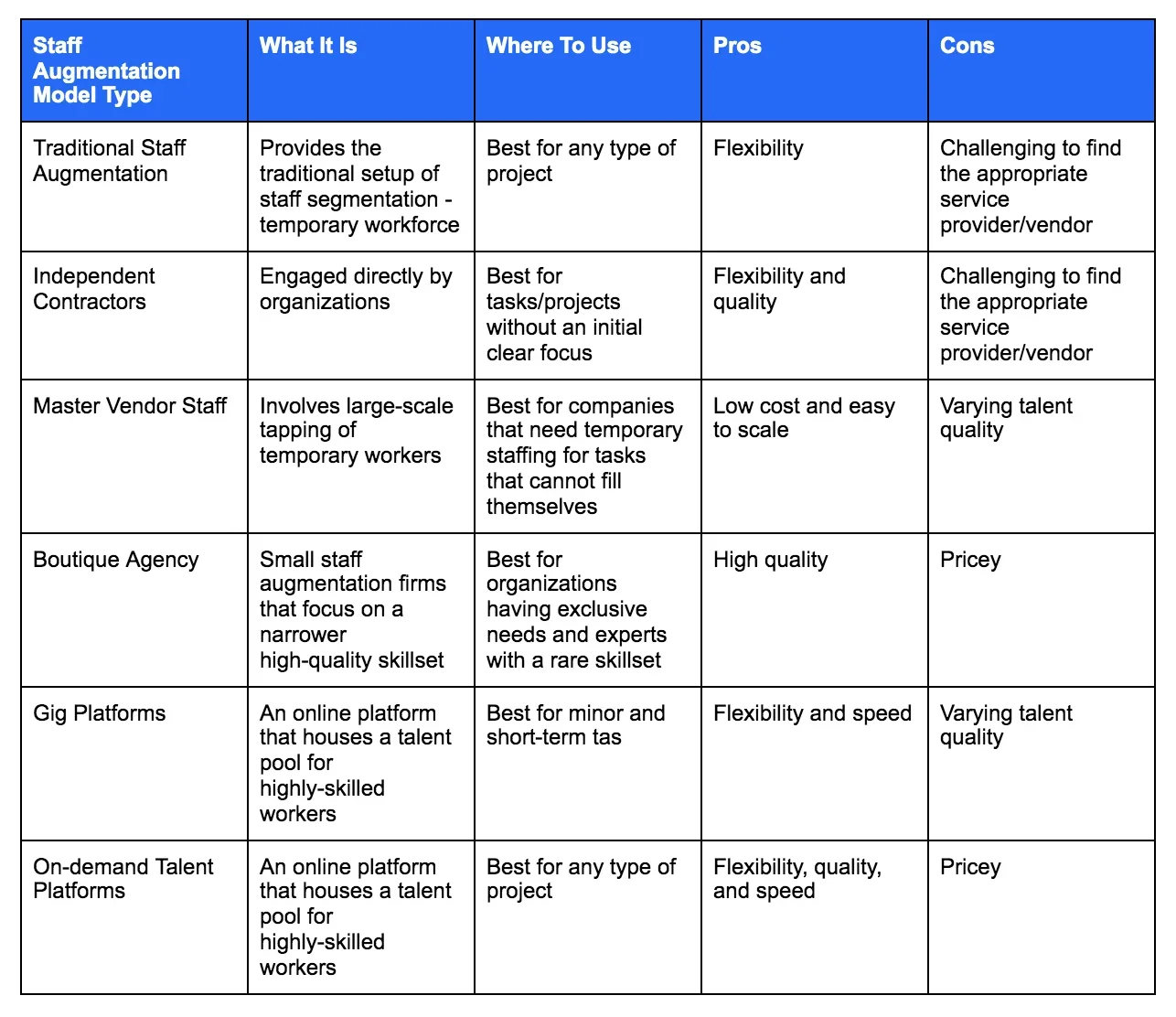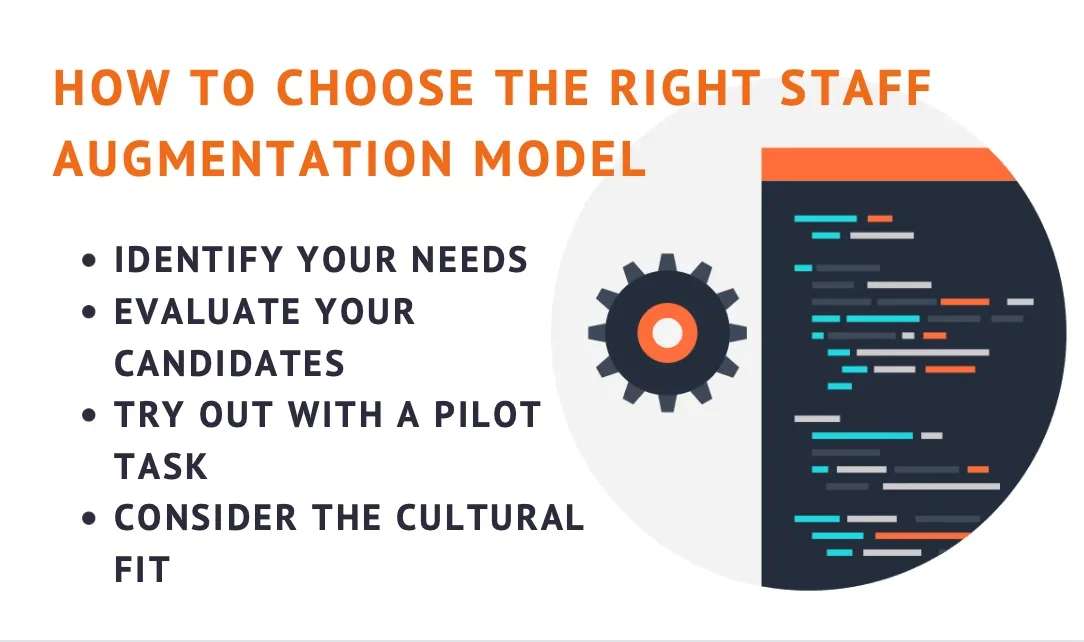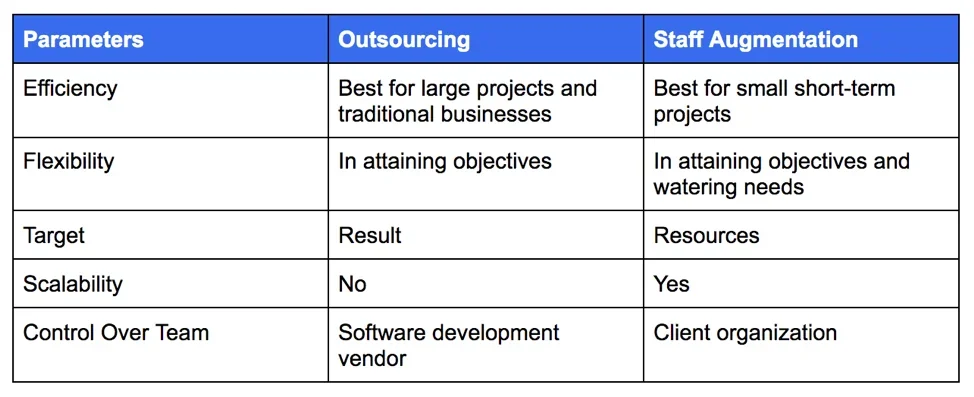Many industries experience projects that require a fluctuating number of experts to keep up with demand while at the same time needing to be cost-effective. Teams are trying to strike a balance between productivity and profitability, leading to the emergence of staff augmentation.
While you’ll mostly hear about IT staff augmentation services, meaning this strategy is mostly utilized for tech talent like software engineers, this strategy can also be applied to other industries needing to enrich their in-house team with additional experts with specific skill sets. In 2024, it's a strategy that is rapidly catching the attention of the market.
If you need experts to make up for short-term scarcities in your team, you’ll have to learn more about staff augmentation. In this post we’ll explain:
- What this strategy is
- How staff augmentation works
- When to use it
- Pros and cons
Let’s get right to it.
Defining Staff Augmentation
Staff augmentation is a strategy that involves tapping an external workforce temporarily to work on project tasks to fill gaps and meet submission deadlines. It’s a hybrid model where an organization’s in-house team and the external experts work on the same project, albeit usually each time is given independent parts to work on.

This strategy requires a prior assessment of the current staff and the project at hand to determine additional proficiencies needed that aren’t utilized regularly. Outside experts from a staff augmentation service provider will temporarily augment that organization's capabilities to reach goals.
What’s good about this approach is that the augmented staff that becomes an extended part of the team don’t become regular employees so they’re only tapped and paid when the needs arise. This also means ending the partnership is easy because they’re aware that the work is on a per-project or per-engagement basis.
An additional reason that makes it cost-efficient is that since the external resources aren’t regular employees, the service provider will be responsible for overhead such as recruitment costs, taxes, and insurance. Using ERP for professional services can also help track billable hours, manage resource allocation, and streamline collaboration between internal teams and augmented staff.
Unlike hiring additional employees that aren’t utilized 100% of the time, augmented staff gets you the workforce only when you need them.
How Staff Augmentation Works
To make it easier to picture out how staff augmentation works, let’s take an example.
Suppose you’re an e-commerce store owner that’s now considering more ways to make shopping easier given that people now opt to shop online than go to physical stores. One thing you can think of is to create a dedicated app for your store to make your brand more accessible to users.
Your current team already has a web expert that keeps the website running, secure, and up-to-date. Though they have the capability to take on the new project, it would mean having too much on their plate and they'll either neglect day-to-day responsibilities or it'll take a lot longer to finish the app.
Here is where you can consider project outsourcing and tap a staff augmentation service provider to provide you with a talent pool of app developers you can choose from. The service provider can find you a dedicated team that won’t have to go through a tedious recruitment process and onboarding so you can reach your business objectives faster.
The vendor takes care of the nitty-gritty part of finding the right candidates for you so you’ll immediately have CVs of qualified app developers you can choose from. You can then interview them, asking questions that would seal the deal, and then a contract can then be signed.
Here’s a 4-step process you can follow with this staff augmentation model:
- Analysis: This involves defining your project, its goals, and what you expect from the external resources you’ll work with. It’ll help you determine faster which specialist you’ll need and what skills you’ll require of them to help you achieve project goals on budget and on time.
- Talent Source: Consider the skill set you need when staffing external experts. Interview all the candidates presented if possible to ensure you’ll get the ones that best cover the skill gap in your current in-house team and ensure you’ll meet your business objectives.
- Onboarding: While the staff augmentation service provider handles all the legal issues, you can onboard the chosen candidate by clearly defining all his roles, responsibilities, and even limitations to avoid confusion.
- Ongoing Support: Service providers ensure managed services so they assign either an account manager or an HR manager to help build a productive relationship.
When To Use Staff Augmentation in 2024
You might be wondering: do I need staff augmentation when I run short of in-house experts for projects? Consider these three things to help you decide if this model is what you should go for.
Project Length
Staff augmentation is best for short-term projects, otherwise, it might be more economical to hire someone who can be part of the in-house team or another outsourcing model like managed services. When we say short-term, we mean staff augmentation is an ideal outsourcing strategy for projects that last anywhere from 3 to 24 months.
Confidentiality
Some projects need to be kept from the public. Others could involve critical intellectual property issues. In cases like this, staff augmentation solutions should undergo cautious consideration.
Yes, a service provider’s signed contract can provide a level of security. But there is an inherent risk when you didn't do all of the hiring and background checks yourself, and don't see the expert face-to-face. So it’s important to consider doing some risk analysis as well.
Decreased Project Costs
As touched on a bit earlier, in the staff augmentation model, the service provider covers management and administrative costs. This includes training, office space, and workstations. You’ll only be paying a fixed amount based on how many staff you need for the project.
It maximizes the budget you spend since you won’t be spending resources for people you’ll only be working with temporarily.

Types Of Staff Augmentation
Staff augmentation has six basic types. In this section, we’ll consider what each type is, where it’s best used together with some pros and cons. It’ll help you decide better which staff augmentation type you should consider for your projects.

I. Traditional Staff Augmentation
- What It Is: Traditional staff augmentation involves approaching a staffing agency and hiring some of their resources to bolster your own in-house team. This provides the traditional setup of staff segmentation of a temporary workforce that's sourced through a staffing agency or service provider.
- Where To Use: Traditional staff augmentation is great because it can be used for any type of project, including both IT and non-IT related engagements.
- Pros: Traditional staff augmentation provides a lot of flexibility in terms of how many external resources you want, and even allows you to have many different options of which exact resources you want to staff on your team.
- Cons: With traditional staff augmentation, the most difficult step is often finding an appropriate service provider/staffing agency with qualified resources.
II. Independent Contractors
- What It Is: Independent contractors involves searching for contractors and directly engaging with them.
- Where To Use: Independent contractors are great for projects without a clear initial focus, as contractors will often be willing to provide input on overall direction. Independent contractors can also be great for when you need to fill just one specific gap in your team and nothing else.
- Pros: Independent contractors are pretty flexible and are usually of extremely high quality. The best part about hiring an independent contractor is most have a varied skillset, meaning you can hire just one contractor to fill multiple gaps.
- Cons: The challenge with hiring independent contractors is finding a reliable and high quality contractor and managing the contractor invoice.
III. Master Vendor Staff
- What It Is: Master vendor staff involves approaching a staffing agency to provide a large quantity of temporary workers.
- Where To Use: Master vendor staff is best for companies that need temporary staffing for a sudden need for increased capacity that the company itself cannot meet.
- Pros: The main benefit of master vendor staff is it's often low cost and easy to scale up to meet huge demands.
- Cons: However, when hiring a large amount of temporary workers in this fashion, it's harder to guarantee quality and you might have inconsistent workers.
IV. Boutique Agency
- What It Is: A boutique agency is a small staff augmentation firm that focuses on a narrower, high-quality skillset.
- Where To Use: Boutique agencies are great for businesses with specific needs or rarer skillsets.
- Pros: Boutique agencies are some of the highest quality workers you can hire.
- Cons: The main drawback of boutique agencies is they tend to be much more expensive than the other options.
V. Gig Platforms
- What It Is: A gig platform is an online platform that houses a talent pool for highly-skilled workers, similar to freelancers.
- Where To Use: Gig platforms are best used for minor and short-term tasks.
- Pros: Gig platforms provide a lot of flexibility and speed if you want to get your project off the ground quickly.
- Cons: Gig platforms suffer from varying levels of quality in the workers, so you'll either have to get lucky or do a good amount of up-front vetting.
VI. On-demand Talent Platforms
- What It Is: On-demand talent platforms are online platform that houses a talent pool for highly-skilled workers but with a bit more structured than gig platforms. Your typical on-demand talent platform will do a lot of vetting themselves so you don't have to.
- Where To Use: Since the platform will do a lot of vetting, these platforms are generally useful for all types of projects.
- Pros: On-demand talent platforms are great for flexibility, quality, and speed.
- Cons: Since the platform will do some of the up-front vetting and management work themselves, they can be a bit more pricier than gig platforms.
How To Choose The Right Staff Augmentation Model
It’s tempting to just look at the immediate benefits, but choosing the right model will make a lot of things easier for you and help you avoid unnecessary delays. Now that you know the staff augmentation types, what else do you need to keep in mind before choosing what to go for? Check these points out.
Identify Your Needs
When considering which staff augmentation model to go for, you can ask yourself questions like:
- What’s my end goal?
- What do I expect from the staff augmentation resources I’ll work with?
- How much time can I dedicate to managing external team members?
- What skill gaps do I want to cover given the current capabilities of my in-house team?
Evaluate Your Candidates
Use the questions above to aid in evaluating your candidates. But more is involved. Even if you need to rush hiring a temporary team member, you still have to take your time in choosing someone carefully. Otherwise, you’ll end up with more delays after you realize you hired the wrong person and need to onboard a new one.
While reviewing your candidates, check on their portfolios and see if they’ve handled similar projects to what you plan on working on. You can also ask for references to vouch for what they are and when possible search for online feedback and reviews as well.
When making the call, ask about their workflow. This will help you gauge how long it takes for them to get tasks done and see if it fits your deadline. This will also show you how adept they are at what they’re doing.
Though not applicable in all cases, candidates who use automation themselves to streamline their work can be considered as a plus factor. You can also present to them your project overview and ask them how they’d go about working on the project.
With staff augmentation, you can hire any external workforce you want from anywhere in the world, this means offshore or nearshore team members are a huge possibility. Consider how you can work around the time zone differences and possible business hours overlap.
Lastly, ask them if they’re interested in the project, when an expert is interested in what they do, they'd be more likely to finish the project ahead or on time.
Try Out With A Pilot Task
To ensure you’re on the same page and if the candidate really has what it takes to help you build your project, start with a pilot task. Testing out is the best verification to see if your requirements are really coming across and to test the candidate's capabilities.
This step is necessary to avoid major roadblocks along the way that can result in unneeded costs and extra hassle.
Consider The Cultural Fit
This is something to keep in mind when working with offshore external team members. Cultural differences can become the major source of hidden costs when miscommunication happens. A huge cultural gap can mean a lower degree of comprehension and predictability.
When this happens, tasks will be completed longer and team leaders might have to micromanage. Hence, consider the culture and work ethics in the recruitment process.

6 Benefits Of Staff Augmentation
1. Flexibility
When working on a project-by-project basis which requires a temporary increase in staffing, you can hire as many specialists as you want. Say you want IT staff augmentation for an app project, you can start with a UX/UI designer, an iOS developer, an Android developer, and two quality assurance engineers. Later on, you can just keep the developers on full-time.
2. Cost Control
Getting more full-time employees to work on a new project requires more resources than staffing specialized professionals temporarily to work on a project on a short-term basis. This way you avoid spending on benefits and salaries on people who may not have the skill set you need after the project is over.
3. High Productivity
The temporary staffing you hire is tapped for a specific task or project. Thus their time and effort will solely be expended on this purpose making way for high efficiency and productivity levels.
4. Knowledge Control
With staff augmentation, you keep an in-house team that’s equipped with core competencies, So while you hire temporary specialists to work on a project, the in-house will still be able to understand and control the technical decisions made. They’ll also still be responsible for domain knowledge. It'll also be easier to onboard new teams in the future since your in-house team are already experts.
5. Speed Of Integration Into Workflow
When you need to hire a full-time team member, you have to deal with all sorts of overhead before you can welcome them to your team and get them on payroll. Whereas when you opt for staff augmentation, integration of the new team member to the workflow will be a lot easier even when done remotely.
6. Offers Objective Perspective
An outside perspective from a temporary specialist will be helpful for companies planning on continuing projects. They can offer out-of-the-box ideas either for workflow practices or project development that the in-house staff may be too busy to think about. It can boost productivity and might just offer something better for the project at hand.
Pros And Cons Of Staff Augmentation
There are always two sides to a coin and staff augmentation is no exception. We’ll consider some pros and cons you can consider before making a resolve about utilizing this strategy and what type to practice.
Advantages Of Staff Augmentation
I. Full Administrative Support
The staff augmentation company is responsible for human resources and recruitment thus saving you from the time and cost associated with this process. Additionally, the staffing provider also covers the expenses for other benefits, insurance, and other bills.
Thus, you can have a sole focus on your business and your project.
II. Access To A Global Pool Of Trained Specialists
While most of your in-house team are recruited locally, outsourcing has no geographical boundaries, you can get access to a worldwide pool of potential team members especially if the staff augmentation company has branches worldwide.
Getting access to a wider pool of talents allows for quicker onboarding of software engineers and IT professionals that fit your specific requirements.
Some regions and countries hold the top talents in certain fields. Staff augmentation helps you tap those people with specialized skills so you can ensure fast and quality projects that meet deadlines.

III. Less Training Needed
With staff augmentation services project management is made easier. You won’t have to spend time getting people to undergo lengthy onboarding processes and training because they’re already fully equipped with the skills you need to get the job done.
Additionally, outsourcing tech developers under staff augmentation services are multi-skilled. They specialize in a wider range of technologies and apps compared to in-house teams. Hence, rather than spend on in-house teams to train new skills, tapping resources that already have the relevant skills makes the project move faster.
IV. Scalability
No matter how many team members you need, staff augmentation gets you access to these specialists when you need them. Once the project is finished you can easily scale workers down and when a new project arises, you can easily add more team members to work on it.
Disadvantages Of Staff Augmentation
I. Technical Expertise
Unless you have time to scrutinize each and every candidate, you can end up with an augmented staff that performs worse than what you expected. Picking the bad egg means repeating onboarding for new hires which means delaying the project.
As mentioned at the outset, other than just asking for portfolios and reviews, work on a pilot task if the specialist is able to deliver on your business objectives.
II. Miscommunication
Again, outsourcing can be global, which means the candidate you're considering might not speak much of the language you're using, resulting in communication errors. If you can’t get vital instructions across, more time is wasted and you'll have to spend more to get it right later.
III. Inefficient Workflows
Unless you get everything in order, employ some automation and SOPs, your workflow could suffer when working with outsourcing models. Prepare in advance by making your processes and workflows succeed even across time zones and cultural barriers.
IV. Security Issues
With staff augmentation, security is a concern if you’re not working with a reputable project outsourcing service provider. Avoid information leaks by performing frequent security audits to locate threats and hazards. Also, make sure to follow a security protocol including getting hold of NDAs signed by the outsourcing company and the augmented staff. It's a good idea to give the external resources temporary accounts and access keys that can be rotated out once their engagement is over.
What’s The Difference Between Staff Augmentation and Outsourcing?
Outsourcing and staff augmentation tend to be used interchangeably, but there’s a thin line that separates one from the other. Check them out in this table:

Efficiency
When it comes to efficiency, traditional project-based outsourcing is best for large projects and traditional business. Staff augmentation is often more efficient for small short-term projects, especially when you already have a handful of experts in-house.
Flexibility
Both outsourcing and staff augmentation can offer a good amount of flexibility.
Target
Outsourcing is best suited when your main objective is results, whereas staff augmentation is better for when your main objective is to have more resources to tackle a problem or a need.
Scalability
On a high level, staff augmentation is more scalable than traditional outsourcing. However, when you work with Aloa, we can offer outsourcing with a high degree of scalability as well.
Control Over Team
When outsourcing the traditional way, you often have less control over your team and resources. With staff augmentation, the resources are effectively members of your staff, so you have control over how they work and spend their efforts. With Aloa, we offer an unprecedented amount of control when working with both outsourcing and staff augmentation models.
Wrapping Up
Staff augmentation is best for cost-effectiveness on short-term projects needing more specialists. It makes the team more productive and the deadline more attainable. Best of all, you get to choose resources from a pool of experienced specialists, and you can be sure of the project quality.
But before saying yes to this strategy, don’t forget to consider the pointers mentioned in choosing the right model together with the pros and cons. When you do, you make the most of this strategy that won’t just benefit your development team, but your organization as a whole. Most companies can't just jump right into staff augmentation without some prep work.
If you have any questions or need help with staff augmentation for your project, don't hesitate to reach out via website chat or [email protected]!

